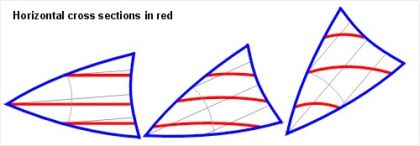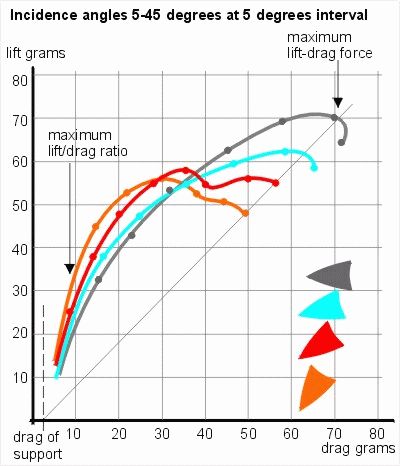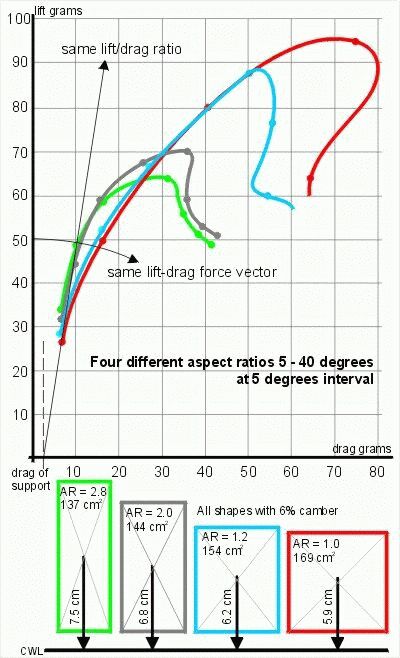Delta Sail in A "Wind Tunnel"
Experiences from B.J. Slotboom
Hi,
If you don't mind I would like to pay some attention to the crab claw rig. I know it is outside the scope of this group but it has everything to do with camber and aspect ratio, two important factors that determine sail performance.
Almost everything that has been said and written about this rig over the last years is based upon Marchaj's analysis as written down in his book 'Sail Performance' (a must for everyone who wants to understand how sails work). Marchaj compared the performance of several rigs : bermudan, lateen, sprit, gunter, lugsail and crab claw sail (unfortunately not a junksail). He was particularly stricken by the reaching performance of the crab claw sail and goes into great lenghts explaining this. His conclusion is that this sail generates lift in a radically different way compared to a bermudan sail.
His explanation is based entirely on the analogy to a deltawing as used on supersonic aircraft like the Concorde. Such a wing can generate a lot of lift at high incedence angles by means of the vortices that develop along its long sweptback side edges. Marchaj calls this vortex lift. He claims that a sail of this shape can do without camber as there is no middle part with a straight leading edge to benefit from it (supersonic aircraft need thin flat wings, but I am sure some camber along the symmetry axis won't hurt at all at low speeds). I think Marchaj went wrong by focusing his attention entirely on the analogy to a deltawing and it is quite easy to show why.
First of all the vortex lift. As we know already vortices are always there at the upper and lower edges of a sail. They are an unavoidable byproduct of lift and are responsible for the lift induced drag. We have also seen that any really low aspect ratio sail generates high lift at high incedence angles because of these vortices. A deltashaped sail is not radically different in this respect. It may be an extreme case of a low aspect ratio sail in the sense that by letting the upper and lower edge meet in a point the middle part with a straight luff is eliminated, but the lift generating process is not fundamentally different.
Back to the crab claw sail. Marchaj admits that a true delta performs best with its axis of symmetry parallel to the airflow, so in the case of a sail horizontal. However his windtunnel tests show that it performs better in the nose down position it usually has. He attributes this to a favourable hull-rig interaction and the windgradient. His tests also show that pointing ability is improved by tilting the sail to a higher position along the mast (higher yard angle).
I think he overlooked two basic factors: camber and aspect ratio. I have prepared a sketch that makes this clear. Let us assume the sail is made out of flat sailcloth. When placed with its axis of symmetry horizontal then a vertical cross-section (perpendicular to the axis of symmetry) will show a curve due to wind pressure but a horizontal cross-section along the axis of symmetry will be a straight line and horizontal cross-sections towards the tips will be almost straight.

Now look what happens if we place the sail in a nose down postion: the horizontal cross-sections will now show a curve so in fact we have introduced some camber into the sail ! The aspect ratio is hardly affected by this so the reaching performance will be about the same but the lift at low incedence angles is improved by the camber. Tilting the sail to a higher position gives the sail more camber and a higher aspect ratio so pointing ability is improved at the expense of reaching performance.
I have made a model of a crab claw sail and gave it some curvature perpendicular to the axis of symmetry and tested it in 4 positions. You can find the lift-drag graph in the same subfolder. This clearly shows that the maximum lift-drag force is generated by the sail in a horizontal position and the maximum lift/drag ratio when the yard angle is highest.

I tested the model as if the yard and boom were attached to the mast, like a junksail, so only the incedence angle varies.
The forward tack of a crab claw sail is usually attached to the bow and the boom is free to move outwards and upwards. At low angles of the apparent wind this makes no difference but as the angle of the apparent wind increases to 90 degrees the wind hits the yard at a perpendicular angle (the same as if the yard were in a vertical position albeit that the force vector now not only points forward and sideways but also upwards). So in order to keep the sail in the 'low' position at high angles the forward tack should be able to move in the direction of the apparent wind.
Now I don't know the effects of hull-rig interaction and windgradient as I test without a hull and there is no windgradient in my windtunnel but I think the performance of this sail can be explained by the same factors (camber, aspect ratio and shape) as that of any other sail and in this respect it is in no way radically different from other sails. Of course it is a very ingenious sail. No doubt the most efficient rig that can be made out of a mast, two poles and a piece of flat cloth and it is the only rig that uses variable geometry to get the best performance on all courses.
I was fooled by Marchaj's interpretation into thinking that the performance of a flat sail could be improved by giving it a delta luff instead of camber. Tests showed that maximum lift was improved (due to the vortices) but lift/drag ratio went down (also due to the vortices) so the idea was quite useless. You can still find a lift-drag graph in the 'windtunnel' folder in the files section.

One last word on aspect ratio and vortices :
Vortices are always there when lift is generated. If you want a high lift/drag ratio for pointing ability you need as little of them as possible because they are responsible for the induced drag. Btw this is bad news for the vortex batten theory. Should lift be generated by vortices off the battens the lift/drag ratio will be low so pointing ability will be poor. The induced drag (vortex activity) is proportional to (lift/height) squared. So for a high lift/drag ratio you need a low lift/height ratio which means a heigh rig (usually high aspect ratio). A low aspect ratio sail can have a high lift/drag ratio if you keep the lift/height ratio down by keeping the lift down (a small amount of camber like a traditional junk rig and the sail set at a low incedence angle). If you want a high lift-drag force, and forget about the lift/drag ratio, for reaching performance you need as much vortices as you can get. Then you need a high lift/height ratio which means a low wide rig (low aspect ratio) that can operate at high incedence angles.